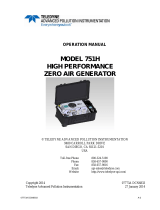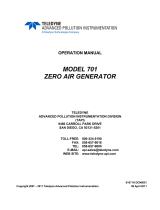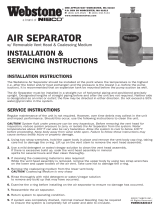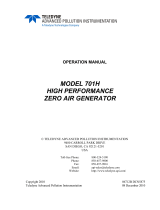Page is loading ...

OPERATION MANUAL
MODEL 751H
HIGH PERFORMANCE
ZERO AIR GENERATOR
© TELEDYNE API
9970 CARROLL CANYON ROAD
SAN DIEGO, CA 92131-1106 USA
Toll-free Phone:
800-324-5190
Phone:
+1 858-657-9800
Fax:
+1 858-657-9816
Email:
api-sales@teledyne.com
Website:
http://www.teledyne-api.com/
Copyright 2014
07773B DCN6940
Teledyne API
23 July 2014


07773B DCN6940
i
ABOUT THIS MANUAL
This Model 751H High Performance Zero Air Generator operation manual is comprised of
multiple documents as listed below.
Part No. Rev Name/Description
07773 B Model 751H Manual (this manual)
07839 A Model 751H Spare Parts List (Appendix A of this manual)
078370100 A Model 751H Interconnect List (Appendix B of this manual)
07837 A Model 751H Interconnect Diagram (Appendix B of this manual)
NOTE
Please read this manual in its entirety before making any attempt to operate the instrument.
REVISION HISTORY
Model 751H User Manual, PN 07773
Date
Rev
DCN
Description
22 Jul 2014
B
6940
Update Altitude spec; add spare part to list
27 Jan 2014
A
6833
Initial Release

ii 07773B DCN6940
This page intentionally left blank.

07773B DCN6940 iii
SAFETY MESSAGES
Important safety messages are provided throughout this manual for the purpose of avoiding personal
injury or instrument damage. Please read these messages carefully. Each safety message is associated
with a safety alert symbol, and are placed throughout this manual and inside the instrument. The symbols
with messages are defined as follows:
CAUTION
This instrument should only be used for the purpose and in the manner described in
this manual. If you use this instrument in a manner other than that for which it was
intended, unpredictable behavior could ensue with
possible hazardous
consequences.
NEVER use any gas analyzer to sample combustible gas(es)!
Note
For Technical Assistance regarding the use and maintenance of this instrument or any
other Teledyne API product, contact Teledyne API’s Technical Support Department:
Telephone: 800-324-5190
Email: [email protected]
or access any of the service options on our website at http://www.teledyne-api.com/
WARNING: Electrical Shock Hazard
HAZARD: Strong oxidizer
GENERAL WARNING/CAUTION: Read the accompanying message for specific
information.
CAUTION: Hot Surface Warning
Do Not Touch: Touching some parts of the instrument without protection or proper tools
could result in damage to the part(s) and/or the instrument.
Technician Symbol: All operations marked with this symbol are to be performed by
qualified maintenance personnel only.
Electrical Ground: This symbol inside the instrument marks the central safety grounding
point for the instrument.

iv 07773B DCN6940
CONSIGNES DE SÉCURITÉ
Des consignes de sécurité importantes sont fournies tout au long du présent manuel dans le but d’éviter
des blessures corporelles ou d’endommager les instruments. Veuillez lire attentivement ces consignes.
Chaque consigne de sécurité est représentée par un pictogramme d’alerte de sécurité; ces pictogrammes
se retrouvent dans ce manuel et à l’intérieur des instruments. Les symboles correspondent aux consignes
suivantes :
AVERTISSEMENT : Risque de choc électrique
DANGER : Oxydant puissant
AVERTISSEMENT GÉNÉRAL / MISE EN GARDE : Lire la consigne
complémentaire pour des renseignements spécifiques
MISE EN GARDE : Surface chaude
Ne pas toucher
: Toucher à certaines parties de l’instrument sans
protection ou sans les outils appropriés pourrait entraîner des
dommages aux pièces ou à l’instrument.
Pictogramme « technicien »
: Toutes les opérations portant ce
symbole doivent être effectuées uniquement par du personnel de
maintenance qualifié.
Mise à la terre
: Ce symbole à l’intérieur de l’instrument détermine le
point central de la mise à la terre sécuritaire de l’instrument.
MISE EN GARDE
Cet instrument doit être utilisé aux fins décrites et de la manière décrite
dans ce manuel. Si vous utilisez cet instrument d’une autre manière que
celle pour laquelle il a été prévu, l’instrument pourrait se comporter de façon
imprévisible et entraîner des conséquences dangereuses.
NE JAMAIS utiliser un
analyseur de gaz pour échantillonner des gaz
combustibles!

07773B DCN6940 v
WARRANTY
WARRANTY POLICY (02024G)
Teledyne API (TAPI), a business unit of Teledyne Instruments, Inc., provides that:
Prior to shipment, TAPI equipment is thoroughly inspected and tested. Should equipment
failure occur, TAPI assures its customers that prompt service and support will be available.
COVERAGE
After the warranty period and throughout the equipment lifetime, TAPI stands ready to
provide on-site or in-plant service at reasonable rates similar to those of other manufacturers
in the industry. All maintenance and the first level of field troubleshooting are to be
performed by the customer.
NON-TAPI MANUFACTURED EQUIPMENT
Equipment provided but not manufactured by TAPI is warranted and will be repaired to the
extent and according to the current terms and conditions of the respective equipment
manufacturer’s warranty.
Product Return
All units or components returned to Teledyne API should be properly packed for
handling and returned freight prepaid to the nearest designated Service Center. After the
repair, the equipment will be returned, freight prepaid.
The complete Terms and Conditions of Sale can be reviewed at http://www.teledyne-
api.com/terms_and_conditions.asp
CAUTION – Avoid Warranty Invalidation
Failure to comply with proper anti-Electro-Static Discharge (ESD) handling and
packing instructions and Return Merchandise Authorization (RMA) procedures when
returning parts for repair or calibration may void your warranty. For anti-ESD
handling and packing instructions please refer to the manual, Fundamentals of ESD,
PN 04786, in its “Packing Components for Return to Teledyne API’s Customer
Service” section. The manual can be downloaded from our website at
http://www.teledyne-api.com under Help Center > Product Manuals in the Special
Manuals section. RMA procedures are under Help Center > Return Authorization.

vi 07773B DCN6940
TABLE OF CONTENTS
ABOUT THIS MANUAL ........................................................................................................... I
REVISION HISTORY ............................................................................................................... I
SAFETY MESSAGES ............................................................................................................. III
1 INTRODUCTION ....................................................................................... 9
1.1 PREFACE ................................................................................................................... 9
1.2 751H FEATURES ........................................................................................................ 9
2 SPECIFICATIONS AND APPROVALS ................................................... 11
2.1 SPECIFICATIONS....................................................................................................... 11
2.2 APPROVALS AND CERTIFICATIONS ............................................................................. 12
2.2.1 Safety .............................................................................................................. 12
2.2.2 EMC ................................................................................................................. 12
3 GETTING STARTED .............................................................................. 13
3.1 UNPACKING ............................................................................................................. 13
3.2 INSTALLATION .......................................................................................................... 13
3.3 INSTRUMENT PANEL ................................................................................................. 14
3.4 ELECTRICAL AND PNEUMATIC CONNECTIONS .............................................................. 15
3.4.1 ELECTRICAL................................................................................................... 15
3.4.2 PNEUMATICS ................................................................................................. 15
3.5 POWER-UP .............................................................................................................. 16
3.6 STORAGE AND TRANSPORTATION .............................................................................. 16
3.7 EXPENDABLE KITS (OPT 42A) .................................................................................. 17
3.8 FLOW RESTRICTOR (OPT 72B) ................................................................................ 17
4 OPERATION ........................................................................................... 19
4.1 OVERVIEW ............................................................................................................... 19
4.2.1 Intake Filter ...................................................................................................... 22
4.2.2 Compressor ..................................................................................................... 22
4.2.3 Cooling Coil ..................................................................................................... 22
4.2.4 Water Trap ....................................................................................................... 22
4.2.5 Water Drain Valve ........................................................................................... 22
4.2.6 Pressure Relief Valve ...................................................................................... 23
4.2.7 Regenerative Dryer .......................................................................................... 23
4.2.8 Pressure Sensor .............................................................................................. 23
4.2.9 Pressure Regulator .......................................................................................... 24

07773B DCN6940 vii
4.2.10 Hydrocarbon (HC) Scrubber ......................................................................... 24
4.2.11 NO-NO
2
Scrubber ......................................................................................... 25
4.2.12 Charcoal Scrubber ........................................................................................ 25
4.2.13 Carbon Monoxide (CO) Scrubber ................................................................. 25
4.2.14 Final Filter ..................................................................................................... 25
4.2.15 Pressure Gauge............................................................................................ 25
4.2.16 Controller ...................................................................................................... 25
4.2.17 Dewpoint Sensor .......................................................................................... 27
4.2.18 Instrument Panel Indicator Lights ................................................................. 27
5 MAINTENANCE ...................................................................................... 29
5.1 SCHEDULE ............................................................................................................... 29
5.2 MAINTENANCE MODE................................................................................................ 30
5.3 CLEANING ................................................................................................................ 30
5.4 CHECKING TUBING ................................................................................................... 30
5.5 REPLACING THE CHARCOAL SCRUBBER MEDIA ........................................................... 31
5.6 REPLACING THE NO - NO
2
SCRUBBER MEDIA ............................................................ 32
5.7 REPLACING THE CO SCRUBBER ................................................................................ 32
5.8 REPLACING THE HYDROCARBON (HC) SCRUBBER ...................................................... 33
5.9 SERVICING THE REGENERATIVE DRYER ..................................................................... 34
5.10 CHANGING THE REGENERATIVE DRYER’S 4-WAY VALVE .......................................... 37
5.11 LEAK CHECK ......................................................................................................... 37
5.12 FILTER ELEMENT REPLACEMENT ............................................................................ 38
5.12.1 Intake Filter ................................................................................................... 38
5.12.2 Final Filter ..................................................................................................... 38
6 TROUBLESHOOTING ............................................................................ 39
APPENDIX A - SPARE PARTS ............................................................................................. 1
APPENDIX B - SCHEMATICS .............................................................................................. 1
LIST OF FIGURES
FIGURE 3-1: 751H STARTUP CONNECTIONS .......................................................................................... 14
FIGURE 4-1: PNEUMATIC DIAGRAM ......................................................................................................... 20
FIGURE 4-2: PLAN VIEW .......................................................................................................................... 21
FIGURE 4-3: INSTRUMENT PANEL ............................................................................................................ 21
FIGURE 4-4: CONTROL BOARD LAYOUT .................................................................................................. 26
FIGURE 5-1: REGENERATIVE DRYER ....................................................................................................... 36

viii 07773B DCN6940
LIST OF TABLES
TABLE 2-1: SPECIFICATIONS .................................................................................................................... 11
TABLE 4-1: POWER AND DEWPOINT CONDITION INDICATORS ................................................................. 27
TABLE 5-1: MAINTENANCE SCHEDULE...................................................................................................... 29
TABLE 6-1: TROUBLESHOOTING .............................................................................................................. 39

07773B DCN6940
9
1 INTRODUCTION
1.1 Preface
The 751H is an excellent source of clean, dry air for dilution calibrators. It also may be
used as a source of purge air for permeation tube ovens, zero air for ozone generators,
or combustion air for FID analyzers. The 751H has an oil-free and diaphragm-free
pump that pushes air through a pre-cooler and water trap that removes moisture, and
passes the air through a regenerative, heatless dryer for final drying. The pump then
routes the dry air through multiple scrubbers that remove SO
2
, NO, NO
2
, O
3
, H
2
S, CO,
and Hydrocarbons; the outlet air passes through a final filter to assure a clean, dry,
analytical zero air supply.
The regenerative dryer removes water and produces gas with a dewpoint of less than
-20°C (up to 10 SLPM flow rate) independent of the inlet dewpoint, and assists in the
removal of other gases, greatly increasing the life of the chemical scrubbers. The 751H
is an ideal accessory to the Model T700 Mass Flow Calibrator or Model 702 Single
Point Calibrator as a zero air source for analyzers.
1.2 751H Features
• Regenerative, heatless dryer for maintenance-free water removal independent of
inlet dewpoint
• Long life scrubbers for SO
2
, NO, NO
2
, O
3
, H
2
S, CO, and Hydrocarbons
• Automatic water drain
• May be used to provide combustion air for FID
• Source of purge air for permeation tube ovens
• Source of zero air for Ozone Generators

Introduction Teledyne API M751H High Performance Zero Air Generator
10 07773B DCN6940
This page intentionally left blank.

07773B DCN6940
11
2 SPECIFICATIONS AND APPROVALS
2.1 Specifications
Table 2-1: Specifications
Parameter Specification
Output 10 SLPM at 30 psig
Max delivery pressure 30 psig
Dewpoint*
< -20°C
Dryer Regenerative heatless dryer with lifetime of greater than 5 years
Output Concentration
SO
2
<0.025 ppb
NO <0.025 ppb
NO
2
<0.025 ppb
O
3
<0.3 ppb
CO < 10 ppb
HC < 0.25 ppb
Compressor Single-cylinder, internal long-life, oil-less piston pump
Dimensions 9” x 22” x 13.8” (229 x 559 x 351 mm)
Weight 47 lbs (21.3 kg)
Operating Temp
5-40°C
Power Typical Power Consumption
110-120 V~ 60 Hz, 4.0 A
220-240 V~ 50 Hz, 3.0 A
320 W
425 W
Environmental Conditions Installation Category (Over Voltage Category ) II Pollution Degree 2
Intended for Indoor Use Only at Altitudes ≤ 2000m
Mains Supply Voltage Fluctuations not to exceed ± 10% of the
nominal voltage.
Transient Over Voltages according to Over Voltage Category II
* 230V/50Hz regions can expect normal operation at 6 SLPM or less, at 40 Degree Celsius and saturated ambient conditions.
The pump’s ability to maintain pressure, and thus meet dew point specification, also degrades with altitude above 6000 feet.

Specifications and Approvals Teledyne API M751H High Performance Zero Air Generator
12 07773B DCN6940
2.2 Approvals and Certifications
The Teledyne-API Model 751H Zero Air Generator was designed, tested and certified for Safety
and Electromagnetic Compatibility (EMC). This section presents the compliance statements for
those requirements and directives. For additional certifications, please contract Technical
Support at 1-800-324-5190 or sda_techsupport@teledyne.com.
2.2.1 Safety
IEC/EN 61010-1:2010 (3
rd
Edition), Safety requirements for electrical equipment for
measurement, control and laboratory use.
CE: 2006/95/EC, Low-Voltage Directive
2.2.2 EMC
IEC/EN 61326-1, Class A Emissions/Industrial Immunity
EN55011 (CISPR 11), Group 1, Class A Emissions
FCC 47 CFR Part 15B, Class A Emissions
CE: 2004/108/EC, Electromagnetic Compatibility Directive

07773B DCN6940
13
3 GETTING STARTED
This section provides instructions on the proper installation and power up of the
751H. Refer to Figure 4-2 for the instrument layout and Table 2-1 for the
specifications.
NOTE
Due to mounting screws through its case, the 751H is not considered waterproof.
3.1 Unpacking
CAUTION
TO AVOID PERSONAL INJURY, ALWAYS USE TWO PERSONS TO
LIFT AND CARRY THE 751H.
1. Remove the 751H from its shipping carton.
2. Verify that there is no shipping damage. If there are signs of damage, immediately
advise the shipper, then Teledyne API.
3. Open the lid and check for damage inside.
4. Check the line voltage and frequency label on the instrument to ensure that it
matches the local power source.
3.2 Installation
The basic 751H is a portable, self-contained instrument; there are no installation
instructions other than to ensure adequate support for its weight. However, the
connections must be made to the instrument panel and drain port with the lid open
(see Section 3.4 for connection instructions).
CAUTION
TO AVOID PERSONAL INJURY OR DAMAGE TO THE INSTRUMENT,
ALWAYS OPERATE THE 751H WITH THE LID OPEN.

Teledyne API M751H High Performance Zero Air Generator Getting Started
07773B DCN6940 15
3.4 Electrical and Pneumatic Connections
3.4.1 ELECTRICAL
NOTE
To maintain compliance with EMC standards, it is required that the power cord
length be no greater than 3 meters.
With the power switch in the “OFF” position, connect the power cord from the AC
input connection to the proper power source.
CAUTION
ENSURE THAT THE POWER CORD IS PROPERLY GROUNDED
AND ADEQUATELY RATED FOR THE SPECIFIED POWER
RATING OF THIS INSTRUMENT (SEE SPECIFICATIONS TABLE).
3.4.2 PNEUMATICS
Make the following pneumatic connections:
DRAIN (1/4” swage-type bulkhead union) - Connect 1/4” diameter tubing to the water-
out fitting (refer to Figure 4-2) to avoid the occasional spurts of water ejecting from
the fitting. Ensure the tubing is long enough that the water ejects outside the
instrument.
ZERO AIR OUT (1/4” swage-type bulkhead union) - Connect the AIR OUT port of the
751H to the INLET fitting of the Model 700 Calibrator with clean 1/4” TFE tubing.
Keep this line as short as possible to minimize pressure drops. . The pressure in this
line is adjustable, but should normally be 30 ± 5 psig.

Getting Started Teledyne API M751H High Performance Zero Air Generator
16 07773B DCN6940
3.5 Power-Up
COOLING FAN Requirements
The instrument panel cooling fan draws air IN and requires at least 6” (150 mm) of
clearance for proper operation.
NOTE:
DO NOT BLOCK THE COOLING FAN; ALWAYS KEEP LID OPEN WHEN
INSTRUMENT IS RUNNING.
1. Turn on the instrument panel POWER SWITCH (Figure 3-1).
2. The instrument panel POWER LED should come on.
3. The cooling fan should start immediately.
4. The compressor should start after a few seconds delay. The delay is to allow the
control board to measure the local line frequency.
5. After 30 to 60 seconds, the instrument panel pressure gauge should read 30
psig.
6. When the DEWPOINT LED is lit green, it indicates that the 751H is producing
clean dry air (see Specifications footnote, Table 2-1).
NOTE
If the 751H has been unused for several days, it may take 30-60 minutes for
the DEWPOINT LED to light green. However, for ultra-low-level calibrations,
running the instrument for several hours could be beneficial for achieving
stability and thoroughly scrubbing contaminants.
3.6 Storage and Transportation
If the 751H will not be used for an extended period of time or will be transported, the
following procedure applies:
1. Turn off the 751H.
2. Wait approximately 1 minute.
3. Turn on the 751H. The water drain valve will switch into the open position and
vent any accumulated water through the water drain. (Standing H
2
0 will cause
corrosion)
4. Turn the 751H off.

Teledyne API M751H High Performance Zero Air Generator Getting Started
07773B DCN6940 17
This shut down process will vent any water that has accumulated in the coalescing
filter. It will prevent this water from passing into the 751H in the event that the
instrument is inverted during storage or shipment.
3.7 Expendable Kits (OPT 42A)
A one-year supply of replacement particulate filters and consumable scrubber media
is available from Teledyne API as Option 42A. Refer to Appendix B for a list of
expendables.
3.8 Flow Restrictor (OPT 72B)
An external flow restrictor is available in order to run the 751H without a calibrator or
other external restriction. It is connected to the outlet fitting and restricts the air flow to
9 SLPM, allowing the 751H to build adequate backpressure to operate.

Getting Started Teledyne API M751H High Performance Zero Air Generator
18 07773B DCN6940
This page intentionally left blank,
/







